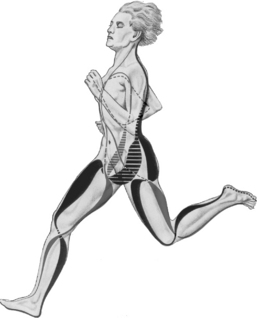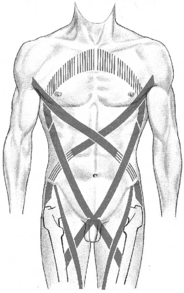3.3 Myofascial chains • Rhomboideus–serratus sling: moves the shoulder blade up/backward or down/forward. • Levator–trapezius sling: moves the shoulder blade up and down. • Trapezius–pectoralis sling: inward or external rotation of the shoulder blade. • Trapezius–serratus sling: forward and backward movement of the shoulder blade. Connecting the spinal column ventrally with the lower extremities: • M. obliquus abdominis externus • Mm. adductorii on the other side • Caput brevis m. biceps femoris Connecting the shoulder ventrally with the foot: Dorsal chain, connecting the arm with the leg on the opposite side: These diagonal muscle slings are of great importance for movement and a wide range of sports such as football, tennis, spear throwing, shot-put, etc.; see Fig. 3.3.1. The following motion patterns were used by Dr. Kabat: • The stretching of shortened or hypertonic muscles dominates the treatment. • Psychic and emotional disorders are, along with traumas, a cause for muscular dysbalance and static disorders.
A review of different models
Kurt Tittel: muscle slings
Muscle slings in static motion patterns
Muscle slings in sidebending and rotation of the trunk
Herman Kabat: proprioceptive neuromuscular facilitation (PNF)
 Flexion left (right) – Extension right (left)
Flexion left (right) – Extension right (left)
 Flexion – sidebending left – rotation left and vice versa
Flexion – sidebending left – rotation left and vice versa
 Extension – sidebending right – rotation right and vice versa.
Extension – sidebending right – rotation right and vice versa.
 Flexion – abduction – external rotation
Flexion – abduction – external rotation
 Extension – adduction – internal rotation
Extension – adduction – internal rotation
 Flexion – adduction – external rotation
Flexion – adduction – external rotation
Godelieve Struyf-Denys




































